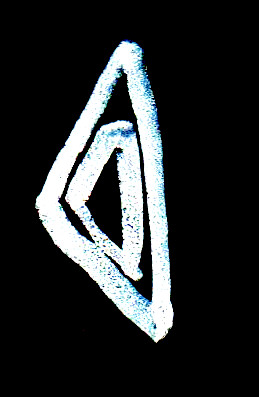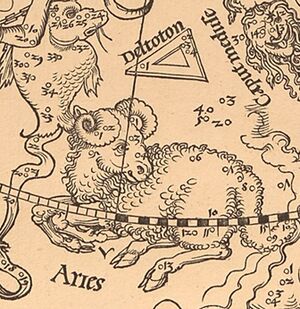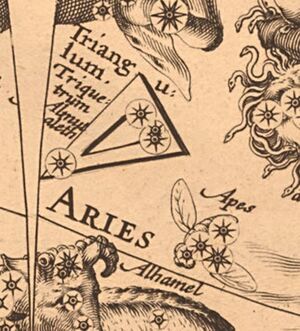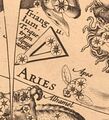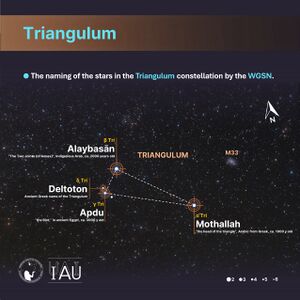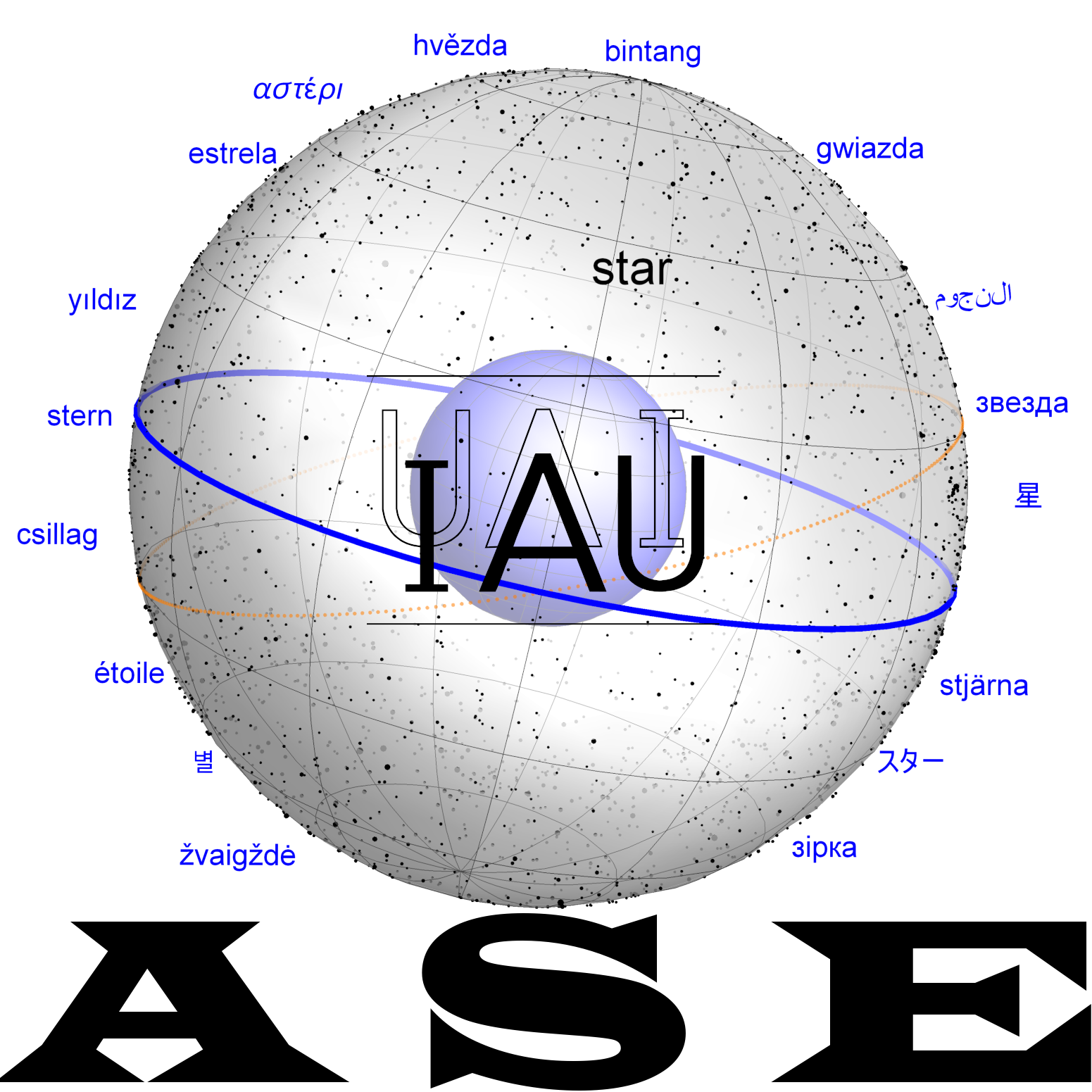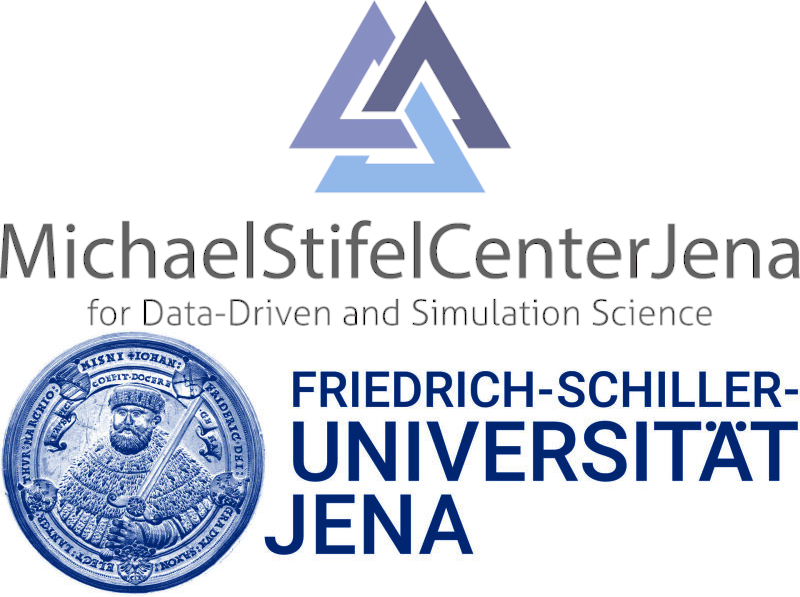Triangulum
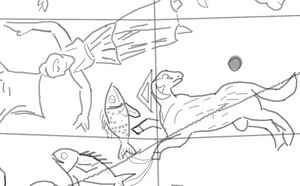
One of the 88 IAU constellations. In Greek antiquity, it was called either Trigonon (Τρίγωνον; triangle), or alternatively Deltoton (Δελτωτόν; the letter Delta: Δ). The alternative name incorporates the religious connection for the ancients, but the constellation is missing from the Farnese Globe and the Mainz Globe.
Etymology and History
Origin of Constellation
The triangle constellation is ancient Greek. It did not exist in Mesopotamia; the stars probably belonged to the Babylonian constellation of the Hired Man, mul lu2ḪUN.GA2 (Aries). Although it was consistently present as a separate constellation in Greece, the authors disagree about its meaning. Aratos calls it ‘the sign’; the mathematical astronomers call it ‘triangle’. Accordingly, Eratosthenes notes that some interpret it as the initial letter of the word ‘Dios’, i.e., as the Greek capital letter Δ (Delta). Dios is the genitive of the name of Zeus. The astronomer reports that when Hermes arranged the constellations in the sky, he inserted ‘of Zeus’ as a possessive inscription - i.e. ‘constellations of Zeus’, the highest god.
Alternatively, Eratosthenes, the librarian of Alexandria and teacher of the princes of Egypt, reported that the constellation was the Nile Delta. He says that the Nile created a triangular outline of Egypt. The constellation, therefore, symbolises the land that the Nile shapes.
The constellation is missing on the globe of the Atlas Farnese, but it is mentioned in all star catalogues: by Eudoxos, Hipparchus, Eratosthenes and Ptolemy. So, it was probably only omitted because it was too delicate or too tiny for the stonemason to fit between the ram and the princess. Interestingly, according to the Almagest, the triangle (Τρίγωνον) consists of four stars, with the fourth star located on one of the connecting lines. In contrast to the (equilateral) southern triangle, this classic triangle is very small and pointed: the fourth star, therefore, does not have to mark the baseline but is located on the smallest of the three edges.
In modern times, the constellation is called ‘the triangle’ by Johann E. Bode, for example. Whether he is referring to the small musical instrument remains a mystery, as the shape of the constellation is not changed. Mathematically, it makes no difference whether this geometry is called ‘three angles’ or ‘three corners’, so that the words "tri-angel" and "drei-eck(en)" are equivalent.
Greco-Roman
Aratus
There is yet another constellation formed near by beneath Andromeda: [235] the Triangle is measured out on three sides, recognisably isosceles; the third side is shorter, but it is very easy to find, for it is well starred compared to the other two. Its stars are a little to the south of those of the Ram. (Kidd 1997)
Eratosthenes
Var. 1 (περὶ τοῦ Δελτωτοῦ): This is the constellation above the head of Aries, and it is said that it is to compensate for its lack of brilliance is an easily recognisable letter, taken from the initial of the name of Zeus, and placed there by Hermes who organised the entire arrangement of the constellations. In fact, some say that Egypt derives its triangular shape from the triangle of the constellation, and that the Nile shape it has given to the contours of the country, not only guarantees its security, but also makes it easier to sow and provide a favourable climate for harvesting the fruits of the earth.
The Triangle has three stars, one on each of its angles, all three shining brightly.
Var. 2 (Δελτωτοῦ): This is the constellation above the head of Aries; it is said that the latter is quite dull, and that an easily recognisable letter is located above him, taken from the initial of the name of Zeus, and placed by Hermes who organised arrangement of the constellations. Some say that Egypt derives its triangular shape from the triangle of the constellation, and that the Nile, by this very shape it has given to the contours of the country, not only guarantees its security, but also makes it easier to sow easier and provide a favourable climate for harvesting the fruits of the earth.
The Triangle has three bright stars, one on each angle. (Pamias and Zucker 2013)
Hipparchus
- not in Hipparchus's lists of rising and setting constellations
- but γ Tri is mentioned as simultaneous culmination with the setting of Aquila, The Eagle
Hyginus, Astronomica
This constellation, which has three angles like the Greek letter Delta, is so named for that reason. Mercury is thought to have placed it above the head of Aries, so that the dimness of Aries might be marked by its brightness, wherever it should be, and that it should form the first letter in the name of Jove (in Greek, Dis). Some have said that it pictures the position of Egypt; others, that of Aethiopa and Egypt where the Nile marks their boundaries. Still others think that Sicily is pictured there. Others, say that three angles were put there because the gods divided the universe into three parts. (Mary Ward 1960)
Geminos
Almagest Τρίγωνον
| id | Greek
(Heiberg 1898) |
English
(Toomer 1984) |
ident. |
|---|---|---|---|
| Τριγώνου ἀστερισμός | Constellation of Triangulum | ||
| 1 | ὁ ἐν τῇ κορουφῇ τοῦ Τριγώνου | The star in the apex of the triangle | α Tri |
| 2 | τῶν ἐπὶ τῆς βάσεως 7 ὁ προηγούμενος. | The most advanced of the 3 on the basic | β Tri |
| 3 | ὁ μέσος αὐτῶν. | The middle one of these | δ Tri |
| 4 | ὁ ἑπόμενος τῶν τριῶν | The rearmost of the three | γ Tri |
| ἀστέρες δ', ὥν γ’ μεγέθους γ', δ’ ἄ. | 4 stars, 3 of the third magnitude, 1 of the fourth |
Arabic Culture
According to Laffitte (2025), there are two star names in the Arabic version of the Greek triangle. One is derived from the translation of the Greek term for "Triangle", the other is of unknown origin:[2]
The Arabs of the classical period borrowed from the Greeks the figure of Δελτωτόν / Deltaton, the ‘Triangle’ introduced by Eudoxus, under the name al-Mutallat, with the same meaning (Ar. al-Muṯallaṯ, al-Ḥağğāğ & Isḥāq. Lat. Triangulum, Gerard of Cremona.), whereas the ancient Arabs considered only the pair called al-Anīsān, ‘the Two Companions,’ (Ar.: al-Anīsān, Ibn Qutayba, al-Ṣūfī > “al-anîsaïn” (ind. case) Schjellerup; al-Šimālī min al-Anisayn, al-Marrākuši > “the second of the Anisaïne”, J. J. Sédillot) in this region of the celestial vault βγ Tri, which became al-Ubaysān, ‘the 2 Arms [ofal-Ḥamal]’, in some manuscripts by al-Ṣūfī.
Mothallah (α Tri: 3.4) / رأس] المثلّث]
Borrowed at the beginning of the 19th century and validated by the IAU, this is a truncation of Ra's al-Muṯallaṯ, ‘the Summit of the Triangle’, in the Greco-Arabic sky and marked on the astrolabe in classical times; Ar. : al-Ḥağğāğ, al-Ṣūfī, then Uluġ Bēg and Al-Tīzīnī. Lat. “Râs AlMothállath”, Hyde, then “râs el-motsallats”, Lach > Râs el-motsallats, Bode, and Mothallah, Piazzi, abs. in Francœur. Ras Al Mothallah, Benhamouda. Var.: not. Mothallah, Metallah and Elmuthalleh, Rassalmotthallah, Allen, not forgetting Caput Trianguli and Tête du Triangle, which are calques of the Arabic name, then Nit. 01. After Allen, Mothallah, Hoffleit, Simbad, UAI. Caput Trianguli, Rhoads.
Mizan [Trianguli] (β Tri: 3.4) / الميزان
Recently introduced, this is the Arabic al-Mīzān, ‘the Balance’, of unknown origin.
Ar. al-Mīzān, ‘the Balance’. Allen gives “Al Mīzān” c/ the Arabs, but does not indicate any source. After him, Al Mizan, Rumrill p/ αβ Tri, and Mizan p/ β Tri, Rhoads.
Medieval and Early Modern Variants
Instrument (Triquetrum)
Plancius on his 1612 globe preserves a name variant for Triangulum:
- Triquetrum.
This is a an ancient instrument for astrometrical measurements.
The brightest star he names Almutaleth which is a derivative of Arabic "Mothallah", The Triangle, adopted for α Trianguli because the phrase the descibes it in the Almagest ends with the word Τριγώνου "triangle".
Many Triangles
Hevelius (1690) created a second triangle from fainter stars which was taken up by several authors.
Ian Ridpath writes:[3]
One of the least imaginative constellations, Triangulum Minus was invented in 1687 by Johannes Hevelius and first depicted on his star atlas, Firmamentum Sobiescianum, published posthumously in 1690. It was formed from three 5th-magnitude stars first catalogued by Hevelius himself. Triangulum Minus lay just south of the existing celestial triangle, Triangulum, which Hevelius renamed Triangulum Majus.
The little triangle achieved surprisingly wide acceptance among astronomers, including Johann Bode who showed it on his Uranographia in 1801. On some charts the pair were jointly named Triangula. Ultimately, though, the little triangle was deemed superfluous to requirements when the constellations came to be rationalized. Its stars were transferred to Triangulum proper where they are now known as 6, 10, and 12 Trianguli.
.
Transfer and Transformation of the Constellation
Mythology
Even Eratosthenes does not narrate any story or mythology.
IAU WGSN naming
- The main star, α Trianguli (3.42 mag), got a name in the early days of WGSN review of star names in 2016: The name "Mothallah" derives the term for "triangle" (al-muthallath) in Arabic and is, therefore, documented in Kunitzsch and Smart (2006).
- Multiple Arabic names for the brightest star, β Tri (3.00 mag), were being reviewed by WGSN before "Alaybasān (الأيبسان)" was adopted.
- For the third star of the prominent triangle, γ Tri, the ancient Egyptian name "Apdu" was adopted.
- The original Ancient Greek term "Deltoton (Δελτωτόν)" was considered for one of the other unnamed stars among the 4 stars listed in the Almagest and adopted for delta Tri, as WGSN likes to pun.
- "Triminus" - a shortened version of Hevelius's "Triangulum Minus" has also been proposed as a name for one of the three stars iota/6 Tri, 10 Tri, and 12 Tri -- of which 6 Tri is the brightest (a quadruple dominated by a G giant).
Weblinks
References
- ↑ Hoffmann (2025), Some Results on the Ancient Globes, Globe Studies – The Journal of the International Coronelli Society, 69, 4169.
- ↑ Roland LAFFITTE (2025). Nommer les étoiles. 500 noms hérités des Arabes. Apport de l'uranographie arabe. Lyon: Orient-des-Mots
- ↑ Ian Ridpath, Star Tales (Online Edition). Triangulum Minus.

